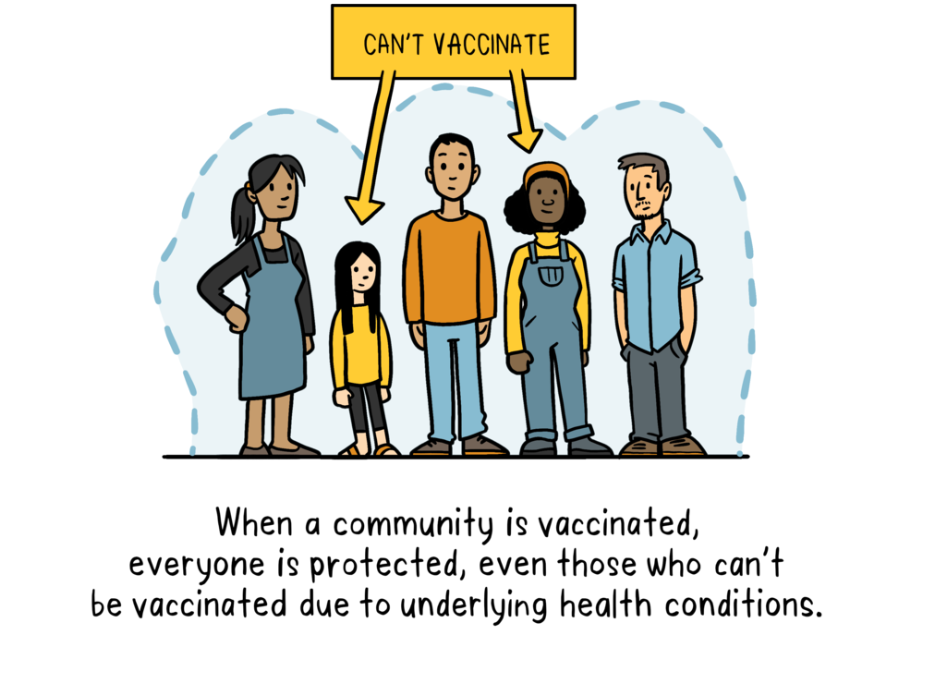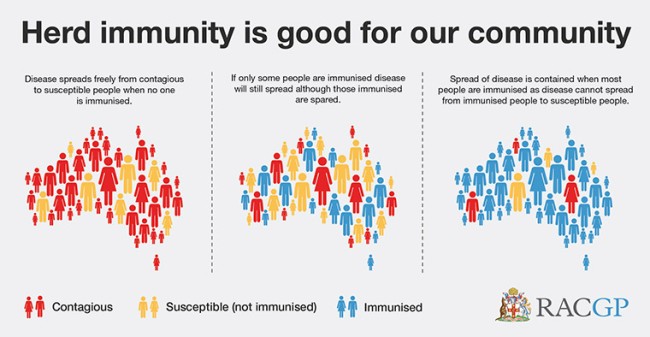Herd immunity
Key points about herd immunity
- Herd immunity, also known as ‘population immunity’, is when a high percentage of people in the community is immune to a certain disease.
- This makes the spread of disease from person to person unlikely and is particularly important to protect a community against dangerous and deadly diseases.
- Herd immunity is achieved through vaccination and/or prior illness with that particular disease.

Herd immunity, also known as ‘population immunity’, is when a high percentage of people in the community is immune to a certain disease. This makes the spread of disease from person to person unlikely. Herd immunity is achieved through vaccination and/or prior illness with that particular disease.
 (The Royal Australian College of General Practitioners, Australia)
(The Royal Australian College of General Practitioners, Australia)
Herd immunity threshold
- Herd immunity is especially important to protect a community against dangerous and deadly diseases.
- Usually, a certain percentage of the population must be capable of getting a disease (unimmunised) for it to be to spread to others. This percentage is called a ‘threshold proportion’.
- If the threshold proportion is lower than the proportion of the population that is immune to the disease (those vaccinated or already had the disease), the spread of the disease will decline.
- This is known as the ‘herd immunity threshold’.
Herd immunity protects the most vulnerable people in our communities; that means people who cannot get vaccinated, eg, babies, pregnant women and people with weakened immune systems, such as those receiving chemotherapy or organ transplants.
When the disease has little opportunity to spread within the community, it is less likely these unvaccinated people will be exposed to it and they can stay safe, too.
This varies from disease to disease; the more contagious a disease is, the greater the proportion of immunised people needed to stop the spread. For example, herd immunity against measles requires about 95% of a population to be immune (known as the threshold). The remaining 5% will be protected by the fact that measles will not spread among those who are immune. For polio, the threshold is about 80%.
Herd immunity doesn’t work once the percentage of immunised people in a population drops below the herd immunity threshold, for example, if less than 95% of people in the community are immunised against the measles. In such a situation, exposure to a contagious disease could spread very quickly throughout the community.
Herd immunity against COVID-19 should be achieved by protecting people through vaccination, rather than exposing them to the virus that causes the disease. This is because the COVID-19 virus can cause serious infection and hospitalisation.
Vaccines train our immune systems to create proteins that fight off disease, known as ‘antibodies’. This mimics what happens when we are exposed to the disease itself but, most importantly, vaccines work without making us very unwell. Once you are fully vaccinated, you are far less likely to fall seriously ill with a COVID infection, and less likely to pass the virus to others.
The proportion of the population that must be vaccinated against COVID-19 to begin herd immunity is not known. This is an important area of research and will likely vary according to the community being studied, the vaccine being used, the populations prioritised for vaccination, and other factors.
References
- Coronavirus disease (COVID-19) – herd immunity, lockdowns and COVID-19(external link) WHO
- Herd immunity(external link) Association for Professionals in Infection Control and Epidemiology (APIC), US
- Herd immunity and COVID-19 (coronavirus) – what you need to know(external link) Mayo Clinic, US
Credits: Healthify editorial team. Healthify is brought to you by Health Navigator Charitable Trust.
Reviewed by: Dr Helen Kenealy, geriatrician and general physician, CMDHB
Last reviewed:
Page last updated:





